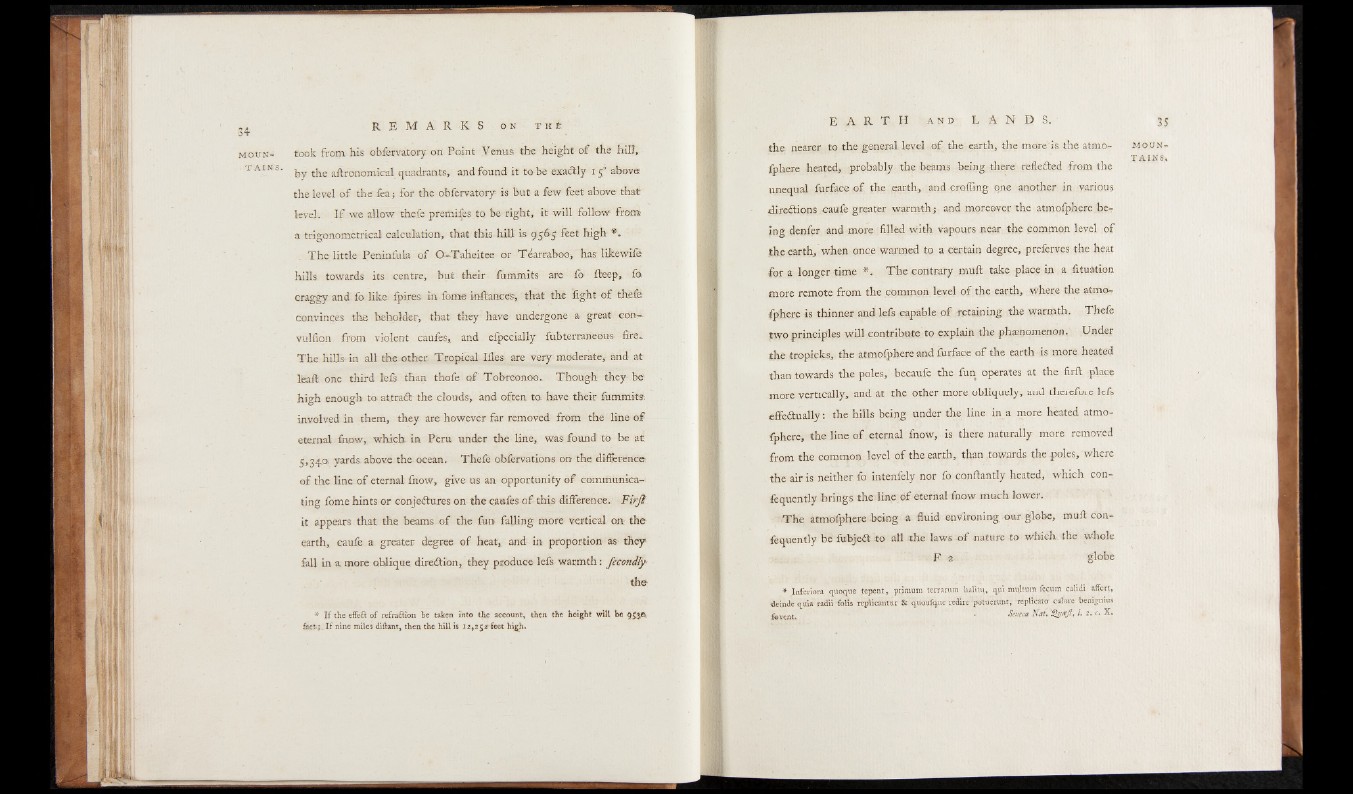
mount
a in s .
took from his obfervatory on' Point Venus the height o f the hill,,
by the aftronomical quadrants, and found it to be exactly I 5° above
the level o f the fea; for the obfervatory is but a few feet above that
level. I f we allow thefe premifes to be right, it will follow from
a trigonometrical, calculation, that this hill is, 956-5- feet high * .
T h e little Peninfula o f O-Taheitee or Téarraboo, has likewifè
hills towards its centre, but their fummits are fo fteep, fa
craggy and fo like fpires in fome inffance's, that the fight o f thefe
convinces the beholder, that they have undergone a- great eon-
vulfion from violent caufes, and efpecially fu,b terraneous- fire..
The hills in all the other. Tropical Ifles are very moderate, and at
leaf! one third lefs than thofe o f Tobreonoo. Though they be
high enough to attradb the clouds, and often to. have their fummit-s:
involved in them, they are however far removed from the line o f
eternal fnow,. which in Peru under the line, was found to be at
5,34.0. yards above the ocean. Thefé obfervations on the difference
o f the line o f eternal fnow, give us an opportunity o f communicating
fome hints or conjectures on the caufes o f this difference. Firjt
it appears that the beams o f the fun- falling more vertical on the
earth, eaufe a greater degree o f heat, and in proportion as they
fall in a more oblique direction, they produce lefs warmth: fecondfy
the-
* I f the effect of refraction be taken into the account, then the height will, be 953A
feet;. I f nine miles diftant, then the hill is 12,25? feet high*
E A R T H and L A N D S.
the nearer to the general level .of the earth, the more is the atmofphere
heated, probably the beams being there reflected from the
unequal furface o f the earth, and crofling one another in various
directions eaufe greater warmth; and moreover the atmofphere being
denfer and more filled with vapours near the common level of
the earth, when once warmed to a certain degree, preferves the heat
for a longer time * . T h e contrary mull take place in a fituat-ion
more remote from the common level o f the earth, where the atmofphere
is thinner and lefs capable o f retaining the warmth. Thefe
two principles will contribute to explain the phenomenon. Under
the tropicks, the atmofphere and iurface o f the earth is more heated
than towards the poles, becaufe the fun operates at the firft place
more vertically, and at the other more obliquely, and therefore lefs
effectually: the hills being under the line in a more heated atmofphere,
the line o f eternal fnow, is there naturally more removed
from the common level o f the earth, than .towards the poles, where
the air is neither fo intenfely nor fo conftantly heated, which con-
fequently brings the line o f eternal fnow much lower.
T h e atmofphere being a fluid environing, our globe, muff con-
fequently be fubjeCt to all the laws o f nature to which the whole
F 2 globe
* Inferiora quoque tepent, prlmum terrarum lialitu, qui multum fecum calidi affcrt,
deinde quia radii folis rcplicantur & qitoufque redire potuerunt, rcplicata cilore benignius
fovent. ' " Seneca L 2. c. X.
MOUNTAINS;,